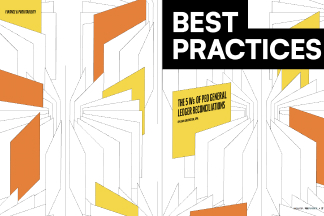Seven years ago, our top business advisor gave me a career-changing lesson.
I was an unlikely candidate for selling PEO at G&A. I did not grow up in Dallas and had no local network. I had no industry experience, nor had I ever been in a sales role before. Worst of all, I’m not sure that I even knew what PEO stood for when I was brought on.
My first two years in the industry were marked by pitch slaps, spray and pray cold calls, proposing to companies that were bad fits, and working with non-decision makers. I clearly remember reaching a point 18 months in, thinking to myself, “I’ll be fired if I don’t start selling!”
I went into 2018 with my back against the wall mentally. Fortunately, we started the year with our annual Sales Kick Off, and I was sat next to our most productive business advisor. In between one of our sessions, I shared with him some of my struggles. He asked me to open my pipeline in our sales management platform and walk him through each of my deals in detail. This is essentially how the conversation went:
“That one will never close – kill it, that one is just kicking tires – kill it, no response in 2 weeks? – kill it,” he said.
“But… but… but…,” I replied.
By the end of it, I still had one legitimate deal left in my pipeline. Here is the valuable lesson he taught me: only spend time on deals that have a high likelihood of closing and become elite at determining what deals those are. From that moment on, my annual sales went up 400% (and never went back down).
It begs the question – how do you determine what can close? Three key factors separate deals that close from those that do not.
1. CLEARLY DEFINED PROBLEM THAT YOU CAN SOLVE
Our prospect needs to have pain that aligns with our value proposition. Selling PEO is nuanced and complex, involving multiple moving parts. Convincing an employer to outsource their back office and co-employ their staff can be challenging, especially for groups who are accustomed to traditional methods (in-house, multi-vendor, etc.).
Often, salespeople mistakenly believe that offering affordable insurance options alone will win over prospects to PEO. For those of us who have tried this, we know that it does not work. Is providing insurance coverage a selling point of our solution? Absolutely! But it is not enough to win support for the model on its own.
Does this mean that your prospect can clearly articulate their problems up front? Not always – however, letting your authentic curiosity guide the conversation can often uncover issues within their business that were not previously front of mind. It is not our job as salespeople to uncover pain that does not exist, or to make mountains of molehills. When real pain does exist though, we can help a prospective buyer quantify and identify underlying pain, and position that pain against the backdrop of the PEO value proposition.
2. ONLY WORKING WITH DECISION MAKERS (OR EXTRAORDINARILY STRONG INFLUENCERS)
We’ve all made this mistake before: proposing to someone who does not have any authority. We identify pain, craft a solution, and save the company money, yet still lose the deal. Why? Because we’re asking our champion to sell our solution internally rather than dealing directly with the decision maker.
Selling PEO is hard. Anyone who has done it for any amount of time can tell you that it is one of the toughest sales you can make. If it is hard for us (who sell PEO for a living), imagine how hard it is for someone who does not have your skillset, training, and understanding of the model to sell PEO to the C-suite without your guidance.
Put yourself in their shoes – by advocating to ownership that the company should abandon their current solution and adopt the PEO model, they are risking significant relational and professional cachet. If issues arise (e.g., poor implementation, high renewal costs, payroll errors), they risk damaging their reputation with executives by having recommended a faulty solution. For this reason, it’s not uncommon for your champion to fold like a cheap lawn chair at the first sign of internal resistance.
Deals that close almost always end with us talking directly to the people who ultimately have authority to purchase.
3. DEFINITIVE TIMELINE / BUYING WINDOW
Timing is everything when selling PEO – it’s about their schedule, not ours. Even with decision makers and clear pain points, a deal may fall through if we miss a critical trigger event.
These events can come in many forms and fashions – a renewal with an incumbent provider/carrier, the start of a quarter/year, loss of a key individual (HR, for example), etc. The reality is, without a clear “backstop” that is forcing them to decide, many employers will simply choose the status quo (do nothing). Deal momentum is key, and the longer a deal stays in our pipeline, the lower our chances of winning it.
It is worth mentioning that we cannot artificially accelerate a timeline that our buyer does not believe in. Attempts to incentivize quick decisions (waived setup fees, free months, more favorable terms, etc.) lower our status in their eyes, and reek of desperation.
From time to time, I am still tempted to chase a low-probability deal to pad my forecast, but then I’ll take a deep breath, and ask myself if it fits my three criteria. If it doesn’t, I’ll pass.
If you’re struggling with low close rates or stalled deals, be brutally honest with yourself by using these three criteria for each opportunity in your pipeline. By walking away from prospects who cannot identify pain, don’t have decision making authority, and are not in a buying window, you’ll free yourself up to spend time with companies that have the highest likelihood of becoming a client.
At the end of the day, there is only one KPI that matters – closed business!
-
SHARE
- Copy to clipboard




